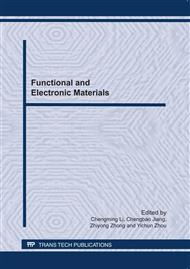[1]
H.K. Kim, H.K. Liou and K.N. Tu: Appl. Phys. Lett. Vol. 66 (1995), p.2337.
Google Scholar
[2]
F. Bartels and J.W. Morris: J. Electron. Mate. Vol. 23 (1994), p.787.
Google Scholar
[3]
P. Yang, in: The effects of high magnetic field on the growth behaviors of tin-copper intermetallic compounds (IMC) layers, Dalian University of Technology, China (2006).
Google Scholar
[4]
G.Y. Li and B.L. Chen: IEEE Transac. Compon. Pack. Technol. Vol. 26 (2003), p.651.
Google Scholar
[5]
F. Zhu, in: The effects of high magnetic field on the growth of intermetallic compounds, Dalian University of Technology, China (2005).
Google Scholar
[6]
W. Yang, W. Robert and J. R. Messler: J. Electron. Mater. Vol. 23 (1994), p.765.
Google Scholar
[7]
J.W. Yoon, Y.H. Lee, D.G. Kim and H.B. Kang: J. Alloys Comp. Vol. 381 (2004), p.151.
Google Scholar
[8]
K.N. Tu and R. D: Acta Metall. Vol. 30 (1982), p.947.
Google Scholar
[9]
K.H. Prakash and T. Sritharan: Acta Mater., 2001, 49(13): 2481-2489.
Google Scholar
[10]
D.Q. Yu, L.L. Duan, J. Zhao, L. Wang and C.M.L. Wu: Mater. Sci. Technol. Vol. 13 (2005), p.532.
Google Scholar
[11]
D.G. Kim and S.B. Jung: J. Alloys Comp. Vol. 386 (2005), p. l5l.
Google Scholar
[12]
P.T. Vianco, P.F. Hlava and A.C. Kilgo: J. Electron. Mater. Vol. 23 (1994), p.583.
Google Scholar
[13]
X. Ma, F. Wang, Y. Qian and F. Yoshida: Mater. Lett. Vol. 57 (2003), p.3361.
Google Scholar
[14]
T.Y. Lee, W.J. Choi and K.N. Tu: J. Mater. Res. Vol. 17 (2002), p.291.
Google Scholar
[15]
L. H. Qi, J.H. Huang, J.G. Zhang, Y. Wang, H. Zhang and X.K. Zhao: Chin. J. Nonferr. Met. Vol. 16 (2006), p.1705.
Google Scholar
[16]
F. Bartels, J.W. Morris: J. Electron. Mater. Vol. 23 (1994), p.787.
Google Scholar
[17]
D.W. Henderson, T. Gosselin, A. Sarkhel, S.K. Kang, W.K. Choi, D.Y. Shih, C. Goldsmith and K.J. Puttlitz: J. Mater. Res. Vol. 17 (2002), p.2775.
Google Scholar
[18]
K. Zeng, K.N. Tu: Mater. Sci. Technol. Vol. 3 (2002), p.55.
Google Scholar
[19]
X.P. Zhang, L.M. Yin, C.B. Yu: Chin. J. Mater. Res. Vol. 22 (2008), p.1.
Google Scholar
[20]
L.M. Yin, X.P. Zhang: Acta Electron. Sin. Vol. 36 (2008), p.1610.
Google Scholar
[21]
F. Ren, J.W. Nah, K.N. Tu, B.S. Xiong, L.H. Xu and J.H.L. Pang: Appl. Phys. Lett. Vol. 89 (2006), 141914.
Google Scholar
[22]
L.M. Yin and X.P. Zhang: Acta Electron. Sin. Vol. 37 (2009), p.253.
Google Scholar
[23]
X.F. Zhang, J.D. Guo and J.K. Shang: Scripta Mater. Vol. 57 (2007), p.513.
Google Scholar
[24]
Z.H. Wu and D.J. Zhou: The basis of surface mount technology (National Defence Industry Press, China 2002).
Google Scholar
[25]
F.D.B. Houghton: Circuit World. Vol. 26 (2000), p.10.
Google Scholar
[26]
S. Rzepka, E. Hofer, E. Simon, E. Meusel and H. Reichl: IEEE Trans. Electron. Pack. Manufact. Vol. 25 (2002), p.127.
DOI: 10.1109/tepm.2002.1021638
Google Scholar


